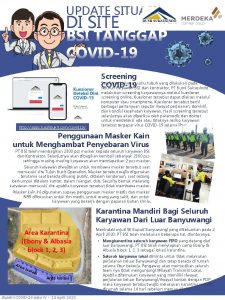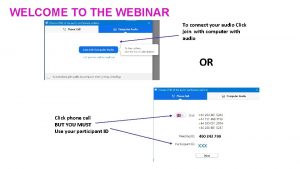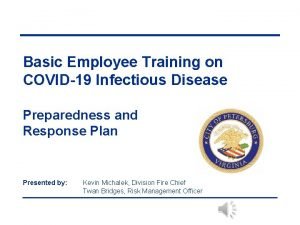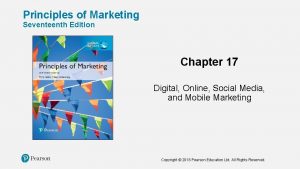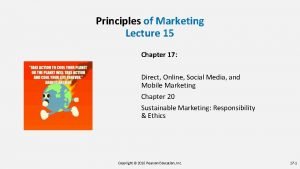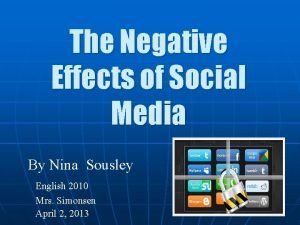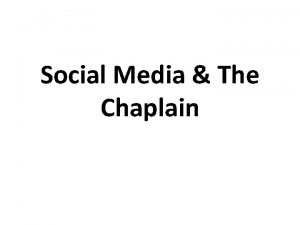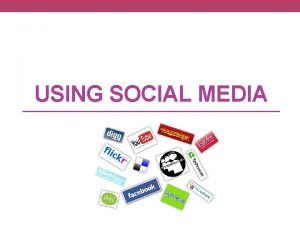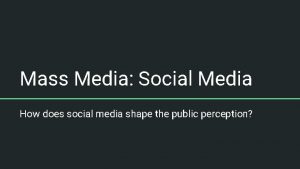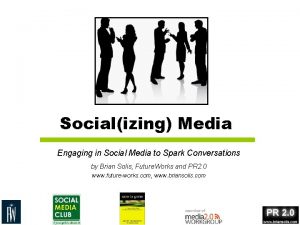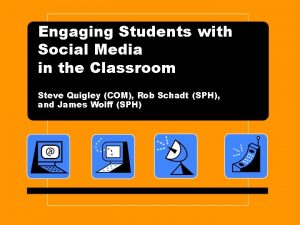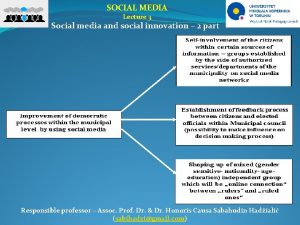Engaging With Students On Social Media During COVID19























- Slides: 23

Engaging With Students On Social Media During COVID-19 Katie Crombe – Associate Director of Admissions, Alma College Ashley Rains – Director of Media & Public Relations, Spring Hill College Kristen Schober Gonzalez – Director of Communication and Marketing, Villa Maria College Carrie Viohl – Marketing Specialist, Southern Regional Technical College Sana Meghani – Virtual Student Support Program Coordinator, Trellis Company Zach Taylor – Institutional Support Consultant, Trellis Company

Webinar Overview • • Introduction Snapshots into COVID-19 and Social Media Importance of Social Media Setting Up an Effective Social Media Strategy Overview of Popular Social Media Platforms Best Practices from Social Media Experts Questions, Answers, and Resources

Expert Panelists Katie Crombe Associate Director of Admissions Alma College Kristen Schober Gonzalez Director of Communication & Marketing Villa Maria College Ashley Rains Director of Media & Public Relations Spring Hill College Carrie Viohl Marketing Specialist Southern Regional Technical College

COVID-19 and Social Media

Importance of Social Media • Over 90% of U. S. adults aged 18 -29 use some form of social media every day. • Platforms such as Facebook, Twitter, You. Tube, and Snapchat include billions of users—and their services are free, aside from data sharing. • Usage increases with education level—college-enrolled adults are more likely to use social media than non collegeenrolled adults. • You. Tube is the most popular social media platform among 18 -29 year-olds. 91% of this demographic uses You. Tube. • Source: Pew Research (2019)

What to Know for Social Media Strategy • • Your school’s voice Your school’s value Your timing What inspires your students What your audience needs right now How to generate content When NOT to post anything

Facebook • Launched in 2004 • 79% of users are between 18 -29 years old • Types of content to focus on for Facebook: • Videos (prerecorded and Facebook Live) • Images/graphics, links/text • Tips & Best Practices: Boost posts to reach a wider audience Host virtual tours of your campus Publish videos to educate and inform students Create moderated Facebook Groups for new students to virtually meet each and engage (i. e. Class of 2024) • Set up a Messenger bot to engage current and prospective students • •

Instagram • Launched in 2010; Facebook-owned in 2012 • 67% of users are between 18 -29 years old • Types of content to focus on for Instagram: • • Images/text Short videos (< 1 min; appear in profile feed) Stories (15 -sec video clips or images; disappear after 24 hours) IGTV live videos (between 60 seconds and one hour) • Tips & Best Practices: • Use highlights to keep important information easily accessible • Create a class account to feature incoming class (ex. @university 2024) • Can cross-populate on Facebook • Host Q&A’s to answer student questions • Host virtual campus tours with live video • Publish short videos that inform students about various processes (applying, housing, etc. )

Twitter • Launched in 2006 • 38% of users are between 18 -29 years old • Types of content to focus on for Twitter: • • Images and text with 280 character limit Live and prerecorded videos Graphics, GIFs, and hyperlinks Cross-posting capacity with Instagram • Tips & Best Practices: • Host Q&A sessions or Twitter Chats for current and prospective students • Engage students with graphics and GIFs, include institutional links to student content • Create different Twitter handles to manage various aspects of your schools (i. e. admissions, student life, financial aid, etc. ) • Respond to users who mention your school’s twitter handle

You. Tube • Launched in 2005; purchased by Google in 2006 • 91% of users are between 18 -29 years old • Types of content to focus on for You. Tube: • Videos and livestreams • Video playlists based on topics • Tips & Best Practices: • Create short, informative videos for all student audiences • Cross-promote You. Tube videos on other platforms • Use ‘Playlists’ to organize videos in your You. Tube channel (i. e. Tips for New Students, Financial Aid, Admissions, etc. )

Snapchat • Launched in 2011 • 62% of users are between 18 -29 years old • Types of content to focus on for Snapchat: • Snaps = images or videos, with text; can add “filters; ” maximum of 10 second video • Stories = collection of images and videos that only approved friends can see • Tips & Best Practices: • Promote school’s Snapchat username on other platforms • Use Snapchat Stories to provide students with engaging content • Create an ambassador application for students and alumni to take over school’s Snapchat account

Tik. Tok • Launched in 2016 • 41% of users are between 16 -24 years old • Types of content to focus on for Tik. Tok: • Short video clips, maximum of one minute • Images and text, can add “filters” • More and more colleges “Reach Gen Z” on Tik. Tok • Tips & Best Practices: • Provide snapshots of student life • Embrace quick-cut editing to optimize information • Trends and hashtags are fleeting—update frequently and monitor trends closely

Linked. In • • Launched in 2002 28% of users are between 18 -29 years old 37% of users are between 30 -49 years old Types of content to focus on for Linked. In: • University news and blog content • Eye-catching visuals and statistics • Student success stories • Tips & Best Practices: • Make sure you have a Linked. In Page set up as “Educational institution” • Use Linked. In to engage your alumni by providing career-related resources and opportunities • Host webinars for students and alumni on career-related topics (preparing for a virtual interview, networking tips, etc. ) • Create Linked. In Groups for alumni to connect and network

Which SM Platforms to Use for Student Engagement Activities • Hosting virtual tours or live Q&A sessions • You. Tube, Instagram, and Facebook • Sharing news and resources with students and alumni • Twitter and Linked. In • Building a community and organizing groups for students • Facebook and Linked. In • Engaging with prospective and current students • Twitter, Instagram, and Snapchat • Providing students with snapshots of student life • Tik. Tok, Instagram, Snapchat, and You. Tube

Searching for Schools Using Social Media Source: https: //www. targetx. com/higher-ed-insights/research/2017 -socialadmissions-report/

Best Practices from Social Media Experts Source: https: //www. targetx. com/higher-ed-insights/research/2017 -socialadmissions-report/

What Works on Our Campuses

What Works on Our Campuses

What Works on Our Campuses

What Works on Our Campuses

Resources • Pew Research: Trends in Social Media Use - https: //www. pewresearch. org/internet/fact-sheet/social-media/ • NASPA: https: //www. naspa. org/blog/5 -ways-to-engage-and-supportstudents-online-during-covid-19 -and-beyond • Center for Disease Control (CDC): https: //www. cdc. gov/coronavirus/2019 ncov/communication/social-media-toolkit. html • National College Attainment Network (NCAN) COVID-19 Resources: https: //www. ncan. org/news/493855/How-the-Education-Field-is. Responding-A-Roundup-of-COVID-19 -Resources. htm • Scientific American’s ‘Harnessing Social Media for the COVID-19 Pandemic’ resource guide: https: //blogs. scientificamerican. com/observations/harnessing-social-media -for-the-covid-19 -pandemic/ • Social Media Today’s Trends in Social Media Amid COVID-19: https: //www. socialmediatoday. com/user_media/ckeditor/nkapoor/2020/0 4/08/top-5 -digital-marketing-trends-for-2020 -during-covid 19. jpg

Questions and Discussion

Proven Services. Extraordinary Support.
 Http//apps.tujuhbukit.com/covid19
Http//apps.tujuhbukit.com/covid19 Do if you covid19
Do if you covid19 Covid19 athome rapid what know
Covid19 athome rapid what know What do if test positive covid19
What do if test positive covid19 Vaksin covid19
Vaksin covid19 Fundal grip
Fundal grip Engaging dynamics
Engaging dynamics Marketing involve engaging directly with carefully targeted
Marketing involve engaging directly with carefully targeted Marketing involve engaging directly with carefully targeted
Marketing involve engaging directly with carefully targeted The negative impact of social media on students
The negative impact of social media on students Social media etiquette for college students
Social media etiquette for college students How jose become the champion of filipino student?
How jose become the champion of filipino student? Media literacy and information literacy venn diagram
Media literacy and information literacy venn diagram Social thinking and social influence
Social thinking and social influence Social thinking social influence social relations
Social thinking social influence social relations Social emotional needs of ell students
Social emotional needs of ell students Social/cultural changes during the 1920's
Social/cultural changes during the 1920's Industrialists of the late 1800s used pools and trusts to
Industrialists of the late 1800s used pools and trusts to Differential vs selective media
Differential vs selective media Contoh rancangan media
Contoh rancangan media Major decisions in advertising
Major decisions in advertising Invasiones en la alta edad media
Invasiones en la alta edad media Cuadro comparativo de la alta y baja edad media
Cuadro comparativo de la alta y baja edad media Examples of hot and cold media
Examples of hot and cold media
